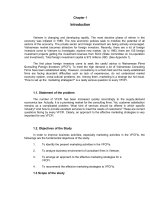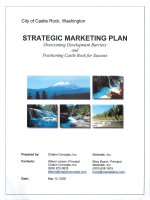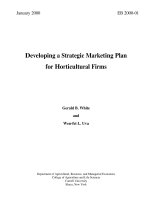STRATEGIC MARKETING PLAN FOR A HOTEL
Bạn đang xem bản rút gọn của tài liệu. Xem và tải ngay bản đầy đủ của tài liệu tại đây (610.08 KB, 63 trang )
Maarit Karppinen
STRATEGIC MARKETING
PLAN FOR A HOTEL
Hotel and Restaurant Business
2011
2
VAASA UNIVERSITY OF APPLIED SCIENCES
Degree Programme of Hospitality Management
ABSTRACT
Author
Maarit Karppinen
Title
Strategic Marketing Plan for a Hotel
Year
2011
Language
English
Pages
59 + 2 Appendices
Name of Supervisor
Peter Smeds
The aim of this thesis was to form a strategic marketing plan for Hotel X, a small
privately owned hotel in Helsinki.
The theoretical part of this thesis presents tourism and marketing from the
hospitality industry’s point of view; what challenges the accommodation
providers face when marketing their products and what kind of plans can be
formed in order to keep their marketing actions up to date.
In the research a qualitative method was used and the data was collected using
semi-structured questionnaire. In-depth interviews were conducted with the hotel
owner and staff members. The results of the research formed the strategic
marketing plan outlining the action plans on how Hotel X should proceed with its
marketing.
Keywords
Marketing, hospitality industry, marketing plan, accommodation
services providers, customer satisfaction
3
VAASAN AMMATTIKORKEAKOULU
Degree Programme of Hospitality Management
TIIVISTELMÄ
Tekijä
Maarit Karppinen
Opinnäytetyön nimi
Strategic Marketing Plan For a Hotel
Vuosi
2011
Kieli
englanti
Sivumäärä
59 + 2 liitettä
Ohjaaja
Peter Smeds
Opinnnäytetyön tavoitteena oli luoda strateginen markkinointisuunnitelma
Hotellille X, joka on pieni yksityisessä omistuksessa oleva Hotelli Helsingissä.
Teoriaosassa tarkastellaan matkailua ja markkinointia majoituspalveluiden
tuottajien näkökulmasta; mitä haasteita majoituspalveluidentuottajat kohtaavat
markkinoidessaan tuotteitaan ja minkälaisia suunnitelmia voidaan luoda
markkinointitoimenpiteiden pitämiseksi ajan tasalla.
Tutkimusosassa käytettiin kvalitatiivista, eli laadullista tutkimusmenetelmää.
Tutkimusaineisto kerättiin teemahaastatteluilla käyttäen niin sanottua seimistrukturoitua kyselykaavaketta. Haastateltavina olivat Hotelli X:n omistaja ja
työntekijät.
Tutkimuksen
tulokset
muodostavat
strategisen
markkinointisuunnitelman, jonka lopussa luodaan toimintasuunnitelma sille,
miten Hotelli X:n pitäisi jatkaa markkinointitoimenpiteitään.
Avainsanat markkinointi, matkailuala, markkinointisuunnitelma,
majoituspalveluidentuottajat, asiakastyytyväisyys
4
Contents
ABSTRACT
TIIVISTELMÄ
APPENDICES .................................................................................................................... 5
1. Introduction ..................................................................................................................... 6
2.
3.
4.
1.1
Aim of the study .................................................................................................... 6
1.2
Structure of the thesis ............................................................................................ 6
1.3
Restrictions ............................................................................................................ 7
1.4
Hotel X .................................................................................................................. 7
Tourism........................................................................................................................ 9
2.1
Definition of tourism ............................................................................................. 9
2.2
Definition of a tourist ............................................................................................ 9
Accommodation services ........................................................................................... 11
3.1
Types of Hotels .................................................................................................... 13
3.2
Hotel Products ..................................................................................................... 14
3.3
Classification systems of hotels ........................................................................... 16
Marketing .................................................................................................................. 19
4.1
Marketing mix ..................................................................................................... 20
4.2
Market segmentation ........................................................................................... 21
4.3
Relationship Marketing ....................................................................................... 23
4.3.1
5.
6.
Different stages of customership .................................................................. 24
Marketing of Hotel Services ...................................................................................... 26
5.1
Internal marketing................................................................................................ 27
5.2
Distribution channels ........................................................................................... 28
Marketing Plan .......................................................................................................... 31
5
6.1.
Situational analyses ............................................................................................ 32
6.2
SWOT-analysis.................................................................................................... 33
6.3
Setting goals / marketing objectives .................................................................... 34
6.4
Marketing strategy ............................................................................................... 35
6.5
Action Plan .......................................................................................................... 36
6.6
Monitoring ........................................................................................................... 36
Research .................................................................................................................... 38
7.
7.1.
Research method................................................................................................. 38
7.2.
Design of questionnaire ...................................................................................... 39
7.3.
Implementation of the research .......................................................................... 40
7.4.
Reliability and validity ....................................................................................... 41
The results of the research ......................................................................................... 42
8.
8.1.
Situational analyses ............................................................................................ 42
8.2.
SWOT-analysis................................................................................................... 43
8.3.
Marketing objectives .......................................................................................... 50
8.4.
Marketing strategy .............................................................................................. 52
8.5.
Action Plan ......................................................................................................... 54
8.5.1.
New customer groups .................................................................................. 54
8.5.2.
Relationship Marketing ............................................................................... 55
8.5.3.
Campaigns ................................................................................................... 56
8.5.4.
Internal Marketing ....................................................................................... 56
9.
Conclusion ................................................................................................................. 57
10.
List of references ..................................................................................................... 58
APPENDICES
6
1. Introduction
Marketing of any kind of services can be challenging but at the same time
interesting. How to market a product in a way that it awakens people’s interest
and make them think, “I want to have that”? Especially since people are more and
more aware of their needs and wants and they will not settle for less.
The basis for this thesis is the fact that I used to work at Hotel X myself. Hotel X
is a small hotel and does not have the big marketing development departments
that other nation-wide hotel chains might have. So what chances does a small
hotel have against such big competitors? As the Hotel X did not have any kind of
clear marketing agendas to start with it gave me a good starting line to start
developing new ideas in regard to marketing the hotel’s services.
1.1 Aim of the study
The aim of the thesis is to create a strategic marketing plan for Hotel X; first to
assess the current marketing situation of the hotel and what possible needs and
gaps it might have. With the basic information of the situation a marketing plan
can be formed. The aim is also for the new marketing plan is realistic and
applicable so that the hotel can use it in their marketing.
1.2 Structure of the thesis
The thesis starts with the theoretical part researching different aspects of
marketing and specifically marketing in a hotel. In the theoretical part the
emphasis is on marketing but the basics of tourism and hotels are also defined and
then continuing on examining more closely on how a marketing plan is formed,
what parts it contains and what different information is needed to form it.
In the empirical part of the thesis there is first the basic information on how the
marketing plan itself will be formed. Starting with the goals of the research as
well as the methods on how information will be gathered. The research continues
to its more active stage where personal interviews of the Hotel staff and owners
7
are conducted. With the information gathered from the theoretical part as well as
from the interviews the strategic marketing plan is formed.
1.3 Restrictions
Marketing can be a very broad concept and it has numerous different aspects to it.
That is why the theoretical part of the thesis is restricted to only research
marketing from a service company’s point of view. The aim is to create a
marketing plan for a hotel so it is important to find out how specifically a hotel
can use marketing and what different marketing tools there are available to do so.
In the empirical part the research is restricted to deal with only the hotel in
question. All the information gathered in the empirical part concerns only Hotel X
meaning that the marketing plan can only be used by the hotel in question.
1.4 Hotel X
Hotel X is a small privately owned hotel in Helsinki, Finland. More precisely it is
located in Malmi, close to the Malmi train station and shopping mall Nova. The
hotel was established in 1989. In the early 90’s the hotel was rented for a couple
of years but then returned to its owners in 1994 and the owners have been
practicing their hotel business at Hotel X since then.
The business idea of Hotel X is to provide accommodation and restaurant services
to its customers. The CEO (chief executive officer) of the company is male and
his wife operates as Hotel Manager. Additionally to the CEO and the hotel
manager there are five permanent employees at the hotel. The restaurant services
of the hotel are outsourced to another company.
In the hotel there are 39 rooms including single and double rooms as well as 3
suites. All of the rooms have air conditioning, minibar, telephone, TV and a
shower. The hotel services also include a bar, buffet breakfast and lunch and á la
carte restaurant in the evenings. Additionally there is also a sauna and a meeting
8
room available. Hotel X also owns and rents two furnished apartments for guests
staying for a longer period of time. The apartments are located near the Hotel X.
9
2. Tourism
Tourism is a relatively new concept in a way that only recently has it been
considered valuable enough to be the object of serious business endeavours or
academic study. Tourism has become a major force in the economy of the world
and recognition of its importance by governments has accelerated the study of
tourism. (Cooper, Fletcher, Fyall, Gilbert & Wanhill 2008: 3-5)
2.1 Definition of tourism
Tourism is a word with many meanings. It includes many different components
and that is why it is difficult to come up with a meaningful definition that can be
universally accepted. It essentially consists of elements such as activities, services
and other industries that deliver the travel experience. Generally people think
tourism to be an industry where people travel to destinations with different
motivations like sightseeing, relaxing on the beach, shopping or visiting friends
and relatives. The World Tourism Organization (WTO) defines tourism as
follows: “Tourism comprises the activities of persons traveling to and staying in
places outside their usual environment for not more than one consecutive year for
leisure, business and other purposes. (Goeldner & Ritchie 2009: 4-7)
2.2 Definition of a tourist
To define a tourist is not a simple matter either; everybody is not the same. People
have different needs and motivations for travelling; they differ for example in
personalities and demographics, and these factors affects considerably on what
type of tourist is in question. The types of tourists can be classified in two basic
ways that relate to the nature of their trip. Are the tourists domestic or
international and what is the purpose of their visit?
Domestic tourists travel within their own country of residence, usually without
anything to do with currency exchange, language barriers or visa implications. In
contrast, an international tourist travels outside the country of residence and there
10
may well be currency, language and visa implication. This distinction between
domestic and international tourist is starting to be vague and more indistinct in
some parts of the world through the collaborations of different countries. For
example the European Union has made it possible to travel to different countries
without having to exchange currency or even need a passport.
The other way to classify tourists is by examining their purpose of visit.
Conventionally there are three categories used. Leisure and recreational tourists
include those who are on a holiday, sports and cultural tourist and people visiting
their friends and relatives. Another category is “other tourism purposes” where a
tourist may be on a study-holiday or visiting the destination due to some health
related issues. Third category is the people travelling for business and professional
purposes and may be taking part for example in a meeting or a conference.
(Cooper et al. 2008: 15)
11
3. Accommodation services
When one travels to another city or country, one usually has different needs and
demands for the destination one is travelling to. Trying to meet these needs and
demands is what comprises the tourism industry. The tourism industry can be
divided into main sectors; hospitality, attractions and event, transport, travel
organizers and intermediaries and destination organization sectors. All of these
sectors can be thought of as range of businesses and organizations involved in
delivering the tourism product and the travel experience. Hotels of course are a
part of the hospitality sector and as such are major essential supply components of
tourism. (Middleton, Fyall & Morgan 2009:10-11)
A hotel is a place that offers its facilities and services for sale. The services can
vary from just one to various combinations that can all be thought of as a part of
the total market concept of the hotel. The basic total market concept consists of
five elements as shown in figure 1.
Figure 1 Market concept of a hotel. (Medlik & Ingram 2000:14)
12
Location is usually the main element, thus being in the center of the market
concept circle, that the visitor takes into account when choosing a hotel. Location
places the hotel geographically into a certain area; for example near a particular
city or village. And if one wants to go to that specific city one has to choose the
hotel within that area. Where the hotel is situated denotes the accessibility and
convenience of the location, attractiveness of the surroundings and other factors
that the visitor sees as appealing when choosing a hotel.
Facilities of a hotel include the bedrooms, restaurants, bars, function and meeting
rooms and recreation facilities such as a gym, tennis court and swimming pool.
Depending on what kind of hotel is in question the facilities vary in number, type
and size. Different visitors have different needs from the hotel and its facilities.
The hotel services comprise the availability as well as the quality in which they
are provided to the customers in the hotel facilities. A hotel can have services
such as 24-hour front desk, concierge and room service. Depending on what kind
of hotel is in question the services can vary on how formal or informal they are,
the degree of personal attention and speed and efficiency.
The image of the hotel can be defined as how the hotel portrays itself to people
and how the people perceive the hotel. The image is a mixture of location,
facilities and services the hotel offers and how they market those elements but
there are also such factors as the hotel’s name and appearance included.
The price comprises the values that are given to the hotel through its location,
facilities and image. The price has to indicate all those elements for if they do not
or the price is some other way determined wrong it will only result in unhappy
customers who feel like they did not get their money’s worth.
All in all, these individual elements of the total hotel concept hold different level
of importance for different people. One person may regard the hotel’s location as
essential and is prepared to accept only basic facilities and services to have it
where as another person may think that the price is the paramount factor when
staying in a hotel and is willing for example to give in a little on the location of
13
the hotel as long as the price is within the range of that particular person. (Medlik
& Ingram 2000: 13-15)
3.1 Types of Hotels
Hotels answer to the demand of those millions of travelers each year who need a
place to stay when visiting other cities and countries. That may be only for one
night or a longer stay of week, even months with each visitor having different
needs and expectations of the hotel’s services. Some may only need a bed to sleep
in for a night, some are coming for a big conference held in the hotel or some are
coming to the hotel for an all-inclusive five-star holiday. (Medlik & Ingram 2000:
4)
To answer the different needs of the visitors, there are different types of hotels,
some offering services targeted to a specific type of customers. Hotels can be
referred to for example as luxury, resort, commercial, residential, transit or in
many other ways. Each of these terms can be linked to what kind of hotel is in
question, give an indication to the location of the hotel or of the main customer
group that uses its services. (Medlik & Ingram 2000: 10-11)
Resort Hotels
A resort hotel is located in an optimal environment with attractive surroundings.
The idea of a resort hotel is to offer a large mixture of services with entertainment
and recreational activities in a way that everything a tourist may need on a
vacation is right there in the resort. The tourist may never have to leave to the
resort during the vacation. These kinds of all-inclusive holidays are typical for a
resort hotel. The resorts can also have been built around a specific theme like a
gambling resort or a spa resort.
Commercial hotels
Commercial hotels are usually located in a city center with its services targeted
for business travelers, convention attendees and vacationers. The location of the
hotel is convenient for these types of travelers who can get to the hotel easily and
get to know the city they are in.
14
Transit hotels
Transit hotels can be divided into two; airport and motor hotels. These hotels are
located, as the name already indicates, near airports and main motorways. Each of
them has similar characteristics for their primary importance for a tourist is their
convenient location when the tourist is going somewhere and needs a hotel room
on the way. So the main pull factor is not the hotel, but the destination the tourist
is going to. The transit hotel serves as a pit stop on the way.
Residential hotels
Residential hotels are usually for long-term visitors who are in town for example
for business for a longer period of time. On that account the hotels are not usually
targeted for tourists, but they may also have some rooms designated for tourists
staying only a shorter time period.
(Medlik & Ingram 2000: 10-13)
3.2 Hotel Products
A typical hotel nowadays offers firstly sleeping accommodation but also food and
beverage services. The bedroom itself is of course the most distinctive product of
a hotel for that is the primary function of the whole accommodation industry; to
offer visitors a bed to sleep in. Depending on what kind of hotel is in question the
hotel can also offer other services for example in a form of recreational facilities
and meeting and conference rooms. Aside from accommodation services that
usually are strictly meant only for the hotel’s residents other services and facilities
are made available also to non-residents.
There are requirements that usually reflect the main customer demand; sleeping
accommodation, food and drink for individual customers as well as for organized
groups. These four requirements relate to accommodation, restaurant, bar and they
function as the principal hotel products. (Medlik & Ingram 2000: 15-17)
15
Figure 2: Defining the hotel product (Bowie & Buttle 2004: 117)
When defining a product an important distinction can be drawn between the core
product, the tangible product and extended product. As shown in figure 2 the
product is a combination of all of them, one supporting the other.
The core product delivers the main benefits that the customer is seeking. In
hospitality industry the core product usually is the sleeping accommodations. But
as different customers have different needs it is always up to the customer to
define what the core product is.
A Tangible product consists of all the physical elements that are necessary so that
the core product can be delivered to the customer. The tangible product includes
product features such as the size and range of facilities, design and quality and
service standards.
If the core product is for example a convenient location to enjoy a good night’s
sleep the tangible products can be a comfortable bed, en-suite bathroom and a TV.
Extended products are composed of intangible elements of the product. Many
times it is the intangible elements that make the same class hotels different from
each other and they are also the elements these hotels compete with among each
16
others. The intangible elements add value, differentiate hotels form each others
and are meant to provide the customer with additional benefits. The extended
product includes elements such as the people; how well the staff is trained and
how well they do their job, accessibility including opening hours and after sales
service meaning for example how well the hotel handles a complaint. Also
nowadays more and more important has become elements such as atmosphere,
brand image and corporate ethics.
(Bowie & Buttle 2004: 116-118)
3.3 Classification systems of hotels
The need for hotel classification systems has been growing along side with the
growth of tourism itself and as more information and technology has become
available for all people. With easier information access and wider exposure for
services and products, travelers now have certain expectations when selecting
travel arrangements and accommodations. A hotel classification system ensures
that the hotel the traveler has chosen meets minimum standards of
accommodation, facilities and service. Even though there is no universal
classification rating in place, there is a range of systems that are accepted and
widely used in most parts of the world. Most classification systems are based on
criteria that consider such factors as hotel size by room account, facilities,
convenience or amenities, quality of service and food and beverage service.
Various symbols and letters, with the most popular being the star rating system,
usually portray ratings. (Gee 1994: 385-386)
One star *
One-star hotels are limited in their services; most of them do not have on-site
restaurant and limited hours may apply to public access and front desk services.
The rooms are very basic and generally small. The rooms may not have a private
bathroom or in-room telephone.
17
Two star **
Two-star hotels are identified by basic and clean accommodations, with some
business services (typically without meeting rooms). On-site restaurants have
limited menus and typically consist of continental breakfast service. The rooms
are comfortable and they typically include telephones and a TV. Room service
and baggage service are usually not included.
Three star ***
Three-star hotels are usually more upgraded and they include more spacious
rooms with quality amenities. The other on-site services include a restaurant with
the possibility for evening dining and possibly even a pool and a small fitness
center. Meeting and conference facilities for business groups and other functions
are sometimes available.
Four star ***
Four-star hotels are very upscale accommodations, offering excellent restaurants,
fine dining, bars, lounges, and complete room service. Other on-site services
include valet parking, concierge services, fitness center and several spacious and
well-maintained pools. Excellent business centers and meeting facilities are
usually present. Inside the rooms high quality linen, bedding, flooring and
amenities are used.
Five star *****
Five-star hotels are characterized by the best in luxury, service, location, fine
dining and exceptional convenience and comfort. Generally offered are special
guest access to golf courses, luxury spa services on site, the latest in fitness center
and gym facilities, tennis courts, and several multiple-purpose pools, concierge
services and complete hotel services. High quality can be seen throughout the
hotel; the rooms, lobbies and other facilities. The service quality is also very high
with professional staff and many 24h services like room service. Excellent
business centers and meeting facilities are usually present in the larger properties.
18
(Homepage of Area Travel Inc, 3.11.2010)
Hotel star ratings are general quality indicators and should be seen only as broad
guidelines in measuring a hotel’s general quality, amenities, and customer
satisfaction; ratings are not meant to be perfectly precise. Due to differing
parameters and criteria used, for example a five-star hotel can mean different
things
in
different
countries.
(Gee
1994:
411-412)
19
4. Marketing
Marketing is often thought to be only selling and advertising. However, marketing
consists of many other functions that can be seen far more important than just the
exchange of goods. (Kotler & Amrstrong 2004: 5)
The American Marketing Association defines marketing as follows:
“Marketing is the activity, set of institutions, and processes for creating,
communicating, delivering and exchanging offerings that have value for
customers, clients, partners and society at large.” (Middleton et al. 2009: 21)
Today, more than ever, marketing has put emphasis on satisfying the customer
needs. The customer tends to make decisions on buying a product or a service
based on their perception of the value and satisfaction that the product or service
delivers. From the company’s point of view the goal of marketing is to first build
and then manage profitable customer relationships. In order to achieve this it is
not enough only to first market the product and then sell it but make sure that the
product being sold will meet the standards and be enough to fulfill the customer’s
expectations. Therefore the company must be aware and understand their
customers; their needs, wants and demands. That is why many companies put a lot
of effort and money into making different kinds of customer surveys analyzing
their customers’ behavior and learning about the different way of delivering the
superior customer value and satisfaction. (Kotler & Armstrong 2004: 5-7)
20
4.1 Marketing mix
The marketing mix is one of the major concepts in modern marketing and is often
brought up in general discussions of marketing. Marketing mix is a set of
marketing tools that a company uses to pursue its marketing objectives in the
target market. When a company is making decisions on marketing they generally
fall into four controllable categories known as the 4 P’s: product, price, place and
promotion.
Figure 3: The four P’s of the marketing mix (Kotler 2004: 58)
As shown in the figure 3; in Kotler’s Marketing mix chart the target market is
placed in the middle. The main idea of marketing is to influence and persuade the
consumer to buy and use the company’s product or service. In order to get
customers to do so a company uses the four P’s as a mixture in order to influence
the demand for its products. (Kotler 2004: 56-57)
In the hospitality industry the products are primarily designed to satisfy the needs
and wants of business and leisure travelers. As part of the marketing mix for
21
example a hotel room can be seen as a product that the company sells to
consumers. Hotel rooms can vary in quality or in services they offer and is
targeted to consumers who usually have the need for a specific type of room. For
example a businessman can have different kind of needs from a hotel room than a
leisure traveler.
In the hospitality industry the place of business is many times the key to success.
A hotel’s location is important for visitors and therefore they usually examine
carefully which hotel and where they choose. The location of the hotel affects the
transportation possibilities, how accessible it is for example from the airport or the
city center. (Bowie & Buttle 2004: 26-27)
Pricing decisions influence the demand and profitability. In a hotel setting for
example the rack rates and agreeing to discount for key accounts are crucial and
require a lot of attention and careful consideration.
Promotion is usually the function of most marketing and sales departments and it
includes all the tools that a company can use to communicate with customers. A
hotel can for example use different websites to advertise their products and
services and also use brand identification to their advantage. (Bowie & Buttle
2004: 28) Brands help consumers to identify what the product or the company is,
for example people relate the Hilton Hotel chain with luxury and good quality.
That helps the hotel chain when they are planning their marketing strategy.
(Bowie & Buttle 2004: 208)
4.2 Market segmentation
In marketing it is almost impossible to succeed by handling all the consumers as a
big “one size fits for all” mass. Market segmentation recognizes that people differ
in many ways like in their needs, attitudes and lifestyles. (Middleton et al. 2009:
97) Through market segmentation companies divide their market into smaller
segments. All of the segments have specific needs and by dividing the market
those needs can be met more efficiently with products and services that match
their unique needs. (Kotler 2004: 239)
22
There are many ways to segment a market. Different segmentation variables are
used, both alone and together, in order to classify consumers into different
segments. Kotler defines four major variables that are generally used in
marketing; geographic, demographic, psychographic and behavioral variables.
Geographical segmentation divides the market into different geographical units
such as cities, regions, countries or climate and population density. By this way
when a company is deciding which units to operate and market, they can pay
attention to geographical differences in needs and wants. For example a major
clothing store chain can pay attention to their selection in stores in northern areas
where it is colder and the need for warmer clothes is greater than in areas located
more south. (Kotler 2004:239)
Demographic segmentation consists of dividing the market into groups based on
variables such as age, gender, family size, income, occupation, education,
religion, race and nationality. Demographic factors are the most popular bases for
segmenting customer groups. This is partly because customer wants are closely
linked to variables such as income and age. Also, for practical reasons, there is
often much more data available to help with the demographic segmentation
process. (Kotler 2004: 240-241)
Psychographic segmentation divides the market into different groups based on
social class, lifestyle or personality characteristics. People can be in the same
geographical segment meaning that they may for example live in the same city;
they can even be of same age. But one may be a student and another a worker.
This affects their lifestyles greatly and therefore also has an effect on the buying
behaviors of the people.
Behavioral segmentation divides buyers into groups based on their knowledge,
attitudes, uses and responses to a product. Behavioral segmentation has the
advantage of using variables that are closely related to the product itself. When a
company knows when and why customers are buying their products, they can link
their marketing to that. For example some holidays like on Valentine’s Day or at
Christmas people tend to buy certain things related to the occasion; many
23
companies prepare special offers and advertisements for those holiday occasions.
(Kotler 2004: 244)
In hospitality industry these same segmentation variables can be used but there is
also a wide range of subgroups that for example almost all of the hotels use.
Hotels usually use only one variable when segmenting these subgroups and that is
the purpose of travel. By defining the purpose of travel hotels can classify many
subgroups such as corporate/business clients, visitors on group package tours,
independent and leisure vacationers. By acknowledging different segments a hotel
can target their services more effectively. (Middleton et al. 2009: 97-99)
4.3 Relationship Marketing
Relationship marketing is a form of marketing that emphasizes customer retention
and satisfaction. It switches the focus from the recruitment of new customer to the
retention and recovery of existing ones. Relationship marketing differs from other
forms of marketing in that it recognizes the long-term value of customer
relationships and extends communication. (Middleton et al. 2009: 92) The world
of marketing today is more customer-centered. As companies must compete in a
more competitive marketplace they have to know their customers’ needs and
wants in order to get new customers, then keep and grow them by delivering
greater value for them. (Kotler 2004: 54)
When planning g a relationship marketing strategy one must take into account that
not all customers want a relationship with the company. That is why it must be
carefully considered which types of customers are usually more likely to repeat
their visit in a hotel or a restaurant. Some customers are aware of the wide choice
of competitor products and services and do not want to limit their options and tie
themselves only to one company but prefer to switch their custom accordingly.
Other customers are not interested in any type of relationship with any company;
they simply look at the best quality, value and convenience available at the time
of purchase. (Bowie & Buttle 2004: 298-299)
24
Building close relationships with key customers should be mutually rewarding for
both the customer and the company. For example to companies that have a lot of
employees working on the road and moving constantly hotel accommodation
becomes a major expense. That is why it is profitable for the company to choose a
particular hotel or a hotel chain and arrange a fixed price for their employees
staying at the hotel. That price is usually lower than the regular rate in the hotel so
the company saves money and the hotel gets a steady income from the company’s
employees staying there. (Bowie & Buttle 2004: 299)
4.3.1
Different stages of customership
When planning relationship marketing it is important to know which ones of the
customers are regulars, who are staying at the hotel just for that one time and who
visit the hotel on more irregular bases. In other words, it is important to know
your customers. When developing relationship marketing there are different
classification systems that can be used to define customers. At simplest customers
can be divided into four different categories. First are the loyal customers who
purchase the company’s services regularly. Second are the customers who
purchase the services and products occasionally but also use competitors’
services. Third are the “not yet”-customers who have been targeted by the
company’s marketing but have not yet purchased their services. Fourth are the
customers who used to use the company’s services but are no longer, for some
reason, doing so. (Rope & Pöllänen 1995: 131-132)
Depending on which category the customer belongs to the marketing strategies
are very different. A company does not necessarily market their services to loyal
customers in the same way as they do to occasional customers. The main
objective when planning marketing to loyal customers is to ensure the continuity
of the customership by keeping the loyal customers happy and invest in direct
marketing. When dealing with occasional customers it is important to start
forming that long lasting relationship for example by targeting the market efforts
to sell the loyal customer’s program. The potential “not yet” customer should be
25
enticed to use the company’s services for example by marketing some special
offers. (Rope & Pöllänen 1995: 133-135)









